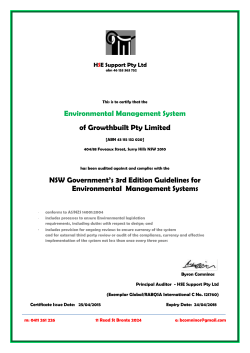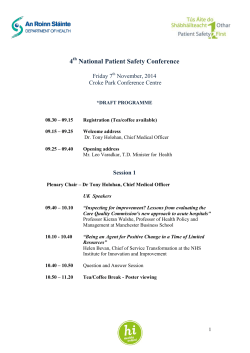
Risk Management Standard
ISO31000 - Risk Management with implementation in Statoil Morten Sørum Seniorrådgiver Sikkerhet - Statoil Classification: Internal Status: Draft History •ISO and IEC standards have included risk management requirements for many years across all disciplines •In 1999 “Guide73: Risk Management – Vocabulary” were issued for those writing standards •15.11.2009 a suit of documents were issued – Main document “ISO31000: Risk Management – Principles and guideline” – A new and more comprehensive version “Guide73: Risk Management – Vocabulary” – Additional standard describing a set of methods, “IEC31010: Risk Management – Risk assessment guidelines” Classification: Internal Status: Draft Hva er risiko? Classification: Internal Status: Draft Classification: Internal Status: Draft What is risk? - Definition •Effect of uncertainty on objectives – NOTE 1 An effect is a deviation from the expected — positive and/or negative. – NOTE 2 Objectives can have different aspects (such as financial, health and safety, and environmental goals) and can apply at different levels (such as strategic, organization-wide, project, product and process). – NOTE 3 Risk is often characterized by reference to potential events (2.17) and consequences (2.18), or a combination of these. – NOTE 4 Risk is often expressed in terms of a combination of the consequences of an event (including changes in circumstances) and the associated likelihood (2.19) of occurrence. – NOTE 5 Uncertainty is the state, even partial, of deficiency of information related to, understanding or knowledge of an event, its consequence, or likelihood. Classification: Internal Status: Draft Statoil HSE Risk Management as part of the management system •Safety •Environmental management •Health and Hygiene •Working environment •Security •Emergency response •HSE management Classification: Internal Status: Draft ISO - Principles for managing risk Gives guidelines and promotes uniformity, but emphasizes the need for purpose built RM a) Creates value b) Integral part of organizational processes c) Part of decision making d) Explicitly addresses uncertainty e) Systematic, structured and timely f) Based on the best available information g) Tailored h) Takes human and cultural factors into account i) Transparent and inclusive j) Dynamic, iterative and responsive to change k) Facilitates continual improvement and enhancement of the organization Classification: Internal Status: Draft Document structure 1. Scope 2. References 3. Terms and definitions 4. RM Principles 5. RM Framework 6. RM Process Annex Document structure 1. Scope 2. References 3. Terms and definitions 4. RM Principles 5. RM Framework 6. RM Process Annex Classification: Internal Status: Draft ISO31000 - Process 1.Communication and consultation 2.Establishing the context 1. Establishing the external context 2. Establishing the internal context 3. Establishing the context of the risk management process 4. Defining risk criteria 3.Risk assessment 1. Risk identification 2. Risk analysis 3. Risk evaluation 4.Risk treatment 1. Selection of risk treatment options 2. Preparing and implementing risk treatment plans 5.Monitoring and review 6.Recording the risk management process Classification: Internal Status: Draft ISO - Risk Management Process diagram Document structure 1. Scope 2. References 3. Terms and definitions 4. RM Principles 5. RM Framework 6. RM Process Annex Classification: Internal Status: Draft Statoil - Risk Management Process RM RM Establish / update context Need for risk assessment RM Identify and analyse risk Base for risk assessment established RM Evaluate risk Risks described RM Decide action Risks prioritised Context changed Implement action and follow up risk Action plan created Risks revised Need for minor update •Same process used for HSE Risk Management •Now uses process modelling for all work – Requirements or sub processes are found by clicking each box •Communication, consultation, monitoring is then sub-processes on some places in the work flow Classification: Internal Status: Draft ISO - Framework 5.1 General 5.2 Mandate and commitment 5.3 Design of framework for managing risk 5.3.1 Understanding of the organization and its context 5.3.2 Establishing Risk management policy 5.3.3 Accountability 5.3.4 Integration into organizational processes 5.3.5 Resources 5.3.6 Establishing internal communication and reporting mechanisms 5.3.7 Establishing external communication and reporting mechanisms 5.4 Implementing risk management 5.4.1 Implementing the framework for managing risk 5.4.2 Implementing the risk management process 5.5 Monitoring and review of the framework 5.6 Continual improvement of the framework Classification: Internal Status: Draft Context - Statoil •Checklists for aspects to be considered when establishing context •Lists internal requirements that are valid company wide •Specifies scales and matrices as guidance, points to examples of risk tolerance criteria Classification: Internal Status: Draft Context is important; cultural example Context defines objectives, external and internal parameters to be taken into account, sets the scope and risk criteria; examples of external context: • Cultural, political, legal, regulatory, financial, technological, economic, natural and competitive • Environment, whether international, national, regional or local; – key drivers and trends having impact on the objectives of the organization; and – relationships with and perceptions and values of external stakeholders. Classification: Internal Status: Draft Environment Comment - Adverse permanent impacts on key ecosystem functions and services in larger natural habitats (e.g. restitution time >10 years) - Adverse impact on globally threatened species. Adverse impact on protected areas of international importance or other areas (non-protected) of international biodiversity value Category 7 and 8 together are often denoted “Major accidents” Category People’s health and safety 8/ Catastrophic - Large scale fatalities (>20), majority of an installation/plant and/or several fatalities for neighbours 7/ Major Several workforce fatalities (4 - 20), larger parts of an installation/plant and/or fatalities for neighbours. Fatalities include work related illness w/ significant life shortening effects. 6/ Severe - 1-3 fatalities on workforce - Serious injury /illness on 3rd party - 1-3 Serious, work related illness or exposure resulting in significant life shortening effects/ fatalities - Adverse long term impact ecologically valuable natural habitats (e.g. restitution time 3 -10 years) - Adverse impact on threatened species on a national level - Adverse impact on protected areas of national importance Serious injury or work related illness with absence from work, restricted work or permanent health effects. High level of medical treatment, serious functional impairment. -Adverse medium term impacts on ecologically valuable natural 4/ Moderate Other injury or work related illness that result in brief absence or restricted/substitute work or some functional impairment. Medically manageable. - Adverse short term impact on the population of one or more species - Adverse short term impact on natural habitats (e.g. restitution time < 1 years) -Adverse impact on protected areas of local importance 3/ Minor Medical treatment, injury or work related illness with need for treatment or with temporary health effect - Very limited impacts on natural habitats - Very limited impact on population level or impact on key species on individual organism levels 2/ Negligible First aid injury or work related illness/effect with limited or no impact on health 5/ Serious 1/ No impact No injury, no work related diseases, no health impact Classification: Internal Status: Draft habitats, or long term impacts on a significant part of such habitats (e.g. restitution time 1 - 3 years) - Adverse medium to long term impact on the population on one or more species - Adverse impact on protected areas of regional importance - No impacts on natural habitats - No impact on population level, only on individual organism level Upside / opprotunity Consequence level, Risk diagram for HSE events – Corporate level +8 +7 +6 +5 +4 +3 +2 +1 0,01 % Probability level -1 -2 -3 -4 Downside Consequence level, -5 -6 -7 -8 Classification: Internal Status: Draft 0,1 % 1% 5% 25 % 50 % 75 % HSE risk matrix, basic guideline This applies to evaluation of single hazards, sources or scenarios, occurring during normal/repeated operational and maintenance tasks. For risk assessment of a total facility including all risk contributors, the matrix is not suitable and other criteria will be needed. Also, for specific, non-recurring activities, separate criteria are indicated on the last page. Probability level 0,01 % -1 -2 -3 -4 Downside Consequence level, -5 -6 -7 -8 Classification: Internal Status: Draft 0,1 % 1% 5% 25 % 50 % 75 % Risikostyringen gjennomføres ved forenklet modell med krav i andre prosesser som triggere Kravene legges inn i prosesser med behov for risikostyring Classification: Internal Status: Draft Kravene linkes mot HSE prosessene 1 Bruker jobber med en prosess som krever at det gjennomføres en form for risikovurdering 2 Krav: I aktiviteten kommer det opp et krav om at det skal gjennomføres risikoanalyse: Gjennomfør en risikovurdering av den/de planlagte prosessen/er ved å bruke en av de følgende risikostyringsverktøy: HSE Risk Management Forenklet risk management Sikker Jobb Analyse Informasjon: Valg av risikostyringsverktøy avhenger av planleggingshorisont og aktiviteten(e)s natur. Følg den beslutningsmodellen nedenfor for å identifisere korrekt verktøy. Beslutningsmodell… Classification: Internal Status: Draft HSE risk matrix, One of a kind operation 1 Impact category 2 3 4 5 6 7 8 Probability / operation Classification: Internal 1: 2: 3: 4: 5: 6: 7: 8: <0,01% 0,01%0,1% 0,1% 1% 1% -5% 5% -25% 25% 50% 50% 75% >75% Status: Draft Attributes of enhanced risk management •Key outcomes – The organization has a current, correct and comprehensive understanding of its risks. – The organization's risks are within its risk criteria. •Continual improvement •Full accountability for risks •Application of risk management in all decision making •Continual communications •Full integration in the organization's governance structure Classification: Internal Status: Draft Identify and analyse risk •Systematic run through of operation or system •Checklists are available •Involve HSE professional when needed, they shall know the total process •Involve users, those who know the operations or systems Classification: Internal Status: Draft Example –Risk assessment Integration Impact (Upside) F1 F2 P1 F5 Low Probability W5 W1 P2 W2 P3 S4 S5 F4 F3 S2 S1 S3 Impact (Downside) Classification: Internal Status: Draft High F=Finance S=Safety W=Working environment P=Personnel F1: Efficiency increase F2: Standardisation F3: Implementation plans not well coordinated F4: Large control span, ”Hands on”, ”Snorre A measure” F5,W5,S5: Offer 58+ with no new recruiting, lack of competence and capacity S1: Errors due to frustration, major accident S2: Major accident due to “too much at same time” S3: Major accident due to lack of maintenance backlog (manageable), capacity on critical tasks S4: Emergency preparedness, roles to be defined W1: Errors due to frustration, work accident W2: Work accident due to “too much at same time”, incl stress and psychosocial effects P1: Personnel may rotate between installations, flexibility P2: Loss of platform relationship, personnel rotation P3: Massive opposition from employees, worsened working environment Summary •Almost consensus on the text world wide •Norwegian translation soon •Good principles, but not easy to always meet •Checking compliance to all requirements would damage the process •Risk, context, risk identification and the risk monitoring is new for many •Large number of definitions that should be adhered to also in regulations and company practices •The model is useful Classification: Internal Status: Draft Thank you ISO31000 - Risk Management Morten Sørum Senior Advisor Safety, CSO CHSE SAS m: +47 99160508 e: moso@statoil.com www.statoil.com Classification: Internal Status: Draft
© Copyright 2025









